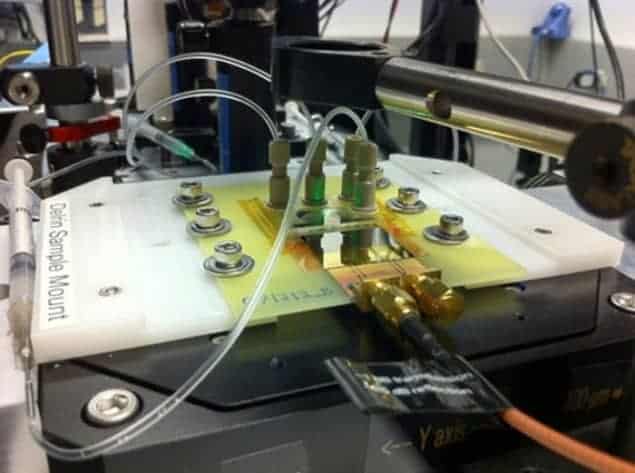
A new electron spin resonance (ESR) technique involving tiny diamonds and optical tweezers has been developed by physicists in the US. The method measures local magnetic fields in liquid environments and could be used to monitor a range of phenomena that occur in fluids – including processes in biological cells and electrochemical devices. Indeed, the team believes that it could use the technique to image electromagnetic fields around neurons in the brain.
The diamonds contained nitrogen vacancies (NVs), which are defects that occur when two neighbouring carbon atoms are replaced by a nitrogen atom and an empty lattice site. An NV has an electronic spin that is extremely well isolated from the surrounding lattice, which means that if the NV is placed in a certain spin state it will remain in that state for a relatively long period of time – even at room temperature. What is more, the spin states can be read out reliably and reinitialized when needed. The structures can therefore be used to store quantum information or as quantum probes to detect magnetic fields in their surroundings.
In this latest work, David Awschalom and colleagues at the University of California, Santa Barbara looked at NV centres in “nanodiamonds” just 100 nm in diameter. He explains that “The nanodiamonds themselves can also be placed with nanometre precision wherever we wish in a sample and be moved around at will, something that has potential applications in sensing, tracking and tagging in submicron biophysical systems.”
The team’s nanodiamonds are trapped using optical tweezers, which involves using a single laser beam that is so tightly focused that dielectric particles such as diamond are pulled to the beam focus rather than being pushed forwards by the beam. The particles are therefore held in the focus, optically levitated and trapped. “By moving the laser focus with respect to the fluidic environment, we can choose where to position the particles using an all-optical technique (no wires or physical contacts needed),” says Awschalom.
Monitoring magnetic fields
Awschalom and colleagues used nanodiamonds that had been commercially irradiated to create more than 500 NV centres in every nanodiamond particle. The researchers then use ESR to measure the energy-level structure of the NV centres. ESR occurs when the electron spins are subjected to a magnetic field, which creates an energy difference between different spin orientations. If the sample is exposed to microwaves with energy equal to this difference, the spins will resonate between the two energy levels. Therefore by measuring the resonant frequency, the magnetic field strength can be determined. “We take advantage of the so-called Zeeman effect, which shifts the spin energy levels of the NV centre, to monitor the magnetic fields detected by the NV sensors in the nanodiamonds,” explains Awschalom.
“Being able to measure the local magnetic field at a chosen location in a fluidic environment using a laser to position the nanodiamond sensor may have multiple applications,” he claims. “For example, it could help improve our understanding of biological cellular processes, electrochemical cells, surface catalysis or lipid membranes. It also offers us a new way to visualize important biological and chemical structures that may be difficult to probe with conventional techniques.”
The team says that it is now interested in using functionalized nanodiamonds that have chemical groups attached to them so that they are attracted to certain molecules. These could be used in microfluidic channels in combination with optical trapping and electron spin resonance to maximize the potential for nanodiamond sensing and on-chip sorting to identify and quantify specific targets.
The work is described in the Proceedings of the National Academies of Science.



